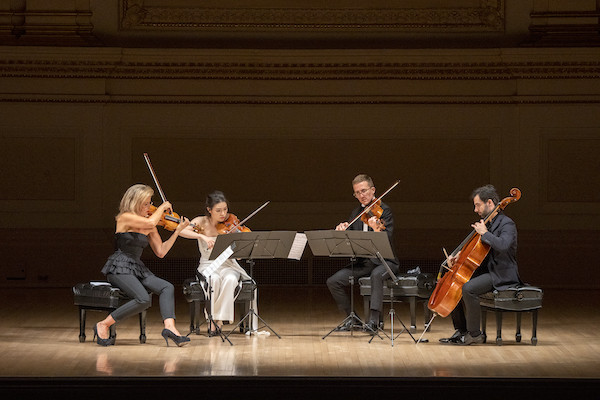Widmann premiere adds dark heft to amiable evening with Mutter and friends

The violinist Anne-Sophie Mutter, once the beneficiary of big-name sponsorship herself (by Herbert von Karajan, among others), now commendably leverages her own celebrity on behalf of young artists with foundation grants, mentorship, and high-profile performance opportunities, such as Thursday’s concert of string quartets at Carnegie Hall billed as “Anne-Sophie Mutter and Friends.”
Thanks to Mutter’s box-office power, three talented emerging artists—violinist Ye-Eun Choi, violist Vladimir Babeshko, and cellist Pablo Ferrández—found themselves performing for a near-capacity audience in the fabled hall, as they joined their famous friend in works by Haydn and Beethoven, and the U.S. premiere of Study on Beethoven (6th String Quartet) by another Mutter friend, the German composer and clarinetist Jörg Widmann.
The canny selection of early works by the old masters found them in the process of, respectively, inventing and re-inventing the string quartet as a medium for four equal players, while retaining enough of the old-fashioned spotlight on the first violinist to please Mutter’s fans.
The other three musicians were no shrinking violets, however, with Ferrández in particular proclaiming Haydn’s emancipation of the cello in brisk exchanges with Mutter and providing a firm foundation to the quartet sound throughout the evening.
The intimate mood of Haydn’s Quartet in E-flat major, Op. 20, no. 1, set a “friendly” tone for the evening, as the players seemed to be feeling their way among each other, with many pauses to reflect. The tender middle movements, marked Minuetto un poco allegretto and Affettuoso e sostenuto, were also much interrupted by pauses and slowdowns; Mutter visibly led the way through the thicket of starts and stops, always sensing the pulse underneath. The players left showy Romantic vibrato behind in favor of a clear, antique-sounding blend of tone, which served equally well in the light, zippy Presto finale.
The Quartet in G major, no. 2 in Beethoven’s first set of quartets Op. 18, shows the young man from Bonn toying with the genre so memorably pioneered by his teacher Haydn. Thursday’s players made the most of the first movement’s unexpected twists, contrasts, and comically pompous development. Mutter’s silvery tone lifted the Adagio cantabile, only to be brushed aside by an allegro episode that the group played with military snap.
Not everybody in the house was an experienced chamber-music listener as was evidenced by the burst of applause that greeted the end of the lively Scherzo, forte and with bows raised high. Mutter nodded to the audience, then smilingly gave a “Wait, there’s more” gesture. And there was more–a taut, energetic performance of the Allegro molto quasi presto finale, with the four players taking turns leading the charge.
With these quartets ringing in one’s ears, it would have been good to go directly to Widmann’s Study on Beethoven, but on hearing that half hour of nonstop music-making, one could appreciate the players’ need for a lengthy intermission before tackling it. (During the performance, Mutter took advantage of rare rests in her part to shake out her bow arm.)
Widmann, who has made a specialty of openly engaging with the old masters in his compositions, composed a cycle of five string quartets between 1997 and 2005, then moved on to other genres. Mutter coaxed him out of quartet retirement in 2019 with a challenge to deal with what he calls “this unapproachable cosmos,” Beethoven. In response, he wrote in a program note, he began with “tonality” as a base, then branched out into “experimentation, variation, and the formulation of exceptions”—a Beethovenesque approach indeed.
The resulting “study” played out as a stream of variations, starting out with a Beethoven-like gesture: two pairs of forte chords standing like massive columns at the temple entrance. At first one heard highly varied but familiar quartet textures, bypassing 21st-century “extended” techniques and even some of the innovations of Bartók, even as the harmonic palette ventured deeper into dissonance.
Soon, however, Widmann was stretching the Beethoven sonic world with stratospherically high passages for the violins, uncanny harmonics, glissandos and microtone intervals. The familiar scene of melodies, dialogue among instruments, and glowing quartet colors was still there, but seen as if in a feverish dream. Bits of a tune blossomed and were snatched away.
For this listener at least, the half hour passed quickly, enlivened by ever-changing incident. The music seemed more desultory than a major statement, as befitted a “study” in old and new ways to compose for string quartet. If the composer keeps the promise he made in the program note, this marks the first step in a new quartet cycle. At the piece’s rather sudden forte conclusion, the applause was long and appreciative—whether of the composer’s achievement, the players’ fortitude, or both, one couldn’t say.
In any case, rather than leave listeners puzzling over a contemporary piece, the players returned with an encore: the witty Molto allegro from Mozart’s String Quartet in D Major, K. 1, which lasted barely a minute.